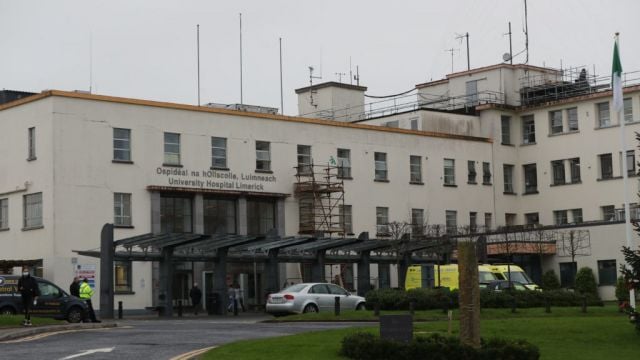Almost 240 people died on trollies at the consistently overcrowded University Hospital Limerick (UHL) over the last five years, the hospital’s chief executive said.
The figures presented to members of the Regional Health Forum West by UHL CEO, Colette Cowan, come in the wake of the inquest into the death of 16-year old UHL patient Aoife Johnston.
The inquest, held at Limerick Coroner’s Court last month, was told by UHL emergency medicine consultant, Dr Jim Gray, that when Aoife died the Limerick hospital’s Emergency Department was, and still is, a “death trap”.
The inquest found Ms Johnson, from Shannon, Co Clare, died of meningitis at UHL after she waited 12 hours for a doctor to examine her in the ED while she lay on a chair dying of sepsis.
The inquest which returned a verdict of medical misadventure last month, heard that antibiotics, which would likely have saved Aoife, had they been given to her in time, were not administered to her for over 15 hours and that by the time she died receive the widely available medication, it was too late.
The hospital’s sepsis protocols were breached, and Aoife should have been seen by a doctor within 10 minutes of presenting at the dangerously crowded hospital, her inquest heard.
The HSE and the UL Hospitals Group have apologised to the Johnson family for acknowledged failings in Aoife’s care. The former Chief Justice, Frank Clarke, is currently conducting an inquiry into the circumstances around Aoife’s death, in December 2022.
Last March, Shannon man, Martin Abbott’s inquest at Limerick Coroner’s Court heard that he may have been lying dead for over an hour on the floor of UHL’s crowded emergency department in 2019 before he was discovered by overworked staff.
The inquest heard Mr Abbott (65) could not be ventilated by a doctor because rigor mortis had already set in.
Mr Abbott’s heartbroken daughter, Ann-Marie Abbott said she hoped the circumstances of her father’s death would serve as a catalyst for change in UHL and the entire Irish health service.
"I just do not know how many more people have to die before the system changes," Ms Abbott warned.
Clare Fianna Fáil Councillor, Cillian Murphy, asked for a breakdown of the number of deaths of patients on trollies at UHL, and several other hospitals in the mid west, west and north-west regions between 2019 and 2023.
In response, figures provided by UHL chief executive Colette Cowan, show that during this five-year period, a total of 239 people died on trollies at UHL.
Ms Cowan said the UHL data included patients “admitted to hospital for whom a bed has been booked but who remained in the ED at the time of their passing” and did “not” include patients who died before arriving at the ED nor critically injured or critically unwell patients who were brought directly to the hospital’s resuscitation room following accidents or sudden illnesses.
“The majority of the above patients (90%) were triaged as the highest category (P1 and P2) indicating a life-threatening illness
or patients who are at end-of-life.”
“In almost all cases, deaths occur in single rooms/cubicles in the zones and in the Clinical Decision Unit, where we use the end-
of-life symbol.”
Ms Cowan added that it had a “strong Patient Advocacy Liaison Service presence for support of patients and families in the ED as well as a bereavement room where families can spend time with their loved one following their death”.
Ms Cowan said the UL Hospitals Group continues to capture the county of origin of patients attending the Limerick ED.
She supplied figures showing that the total number of ED presentations this year up to the 9th May 2024, broken down by county oforigin included:
Clare 7,657 (25 per cent)
Limerick 17,743 (58 per cent)
Tipperary 3,306 (11 per cent)
Other 1,936 (six per cent)
Total 30,642
The Mid West Hospital Campaign group has repeatedly called on the government to reopen Accident & Emergency (A&E) units in Clare and north Tipperary which were closed and reconfigured to Limerick in 2009.
Taoiseach Simon Harris acknowledged reconfiguration was implemented without adequate capacity being put in place at UHL for the additional patient surge.
A 96-bed unit is being built on the hospital grounds, another is proposed, and step-down beds are being provided in the region to try to alleviate the overcrowding crisis.
The health forum heard that 195 people died at Galway University Hospital for the same period; followed by 150 deaths at Sligo University Hospital; 117 at Mayo University Hospital; 108 at Letterkenny University Hospital; and 72 at Portuncula University Hospital.
The figures for deceased patients at Sligo University Hospital was based on deaths in its ED but the hospital said it was “not possible” to state whether the deceased persons were on a trolley or in an ED treatment bay.
“This level of detail would involve an extensive look at each patient record, which would be hugely time consuming,” it said.
Galway University Hospital said deaths in its Emergency Department were recorded as “incidents” on a Quality & Patient Safety management system called
Q-Pulse.
“We have reviewed these records and can confirm the following number of deaths (190) occurred in ED or upon arrival to ED. This data does not contain details specific to whether the patient was on a trolley or in a treatment cubicle/bay. To ascertain this level of detail each patient record would need to be reviewed,” GUH said.
Portuncula University Hospital stated: “We cannot distinguish accurately between those who were admitted patients from ED attendance.”
Mayo University Hospital said: “These (177 patient deaths) are all the totals of patients who died while in the Emergency Department from 2019-2023.”
The Saolta University Health Care Group said it does not record the location of deaths in the Emergency Department (ED) at Letterkenny University Hospital.
“When a patient passes away in the ED,
the majority of whom die in the Resuscitation rooms, the actual location of the death is not routinely documented,” it said.







